By Joseph Spencer and Kelly Estes
Illinois Natural History Survey
University of Illinois
By Nicholas Seiter
Department of Crop Sciences
University of Illinois
It’s not here yet, but there’s a new soybean pest approaching on the distant western horizon. Illinois entomologists were part of a project to survey for it in Illinois during the 2020 growing season.
Resseliella maxima Gagne´(Diptera: Cecidomyiidae), the soybean gall midge (SGM) is a newly-identified pest capable of causing heavy damage in soybean (Gagne´ et al. 2019). Economic damage occurs when the bright orange larvae of the midge (a type of small fly) (Figure 1) feed on the phloem and xylem (vascular tissues) at the base of soybean plants (Figures 2 & 3). Plants that are not killed by an infestation are likely to experience reduced yield. Additional losses are possible due to lodging of weakened plants. Most heavy damage (complete yield loss) is confined to areas within 100 feet of field edges, with 20% yield loss possible within 200-400 feet of the field edges (Figure 4).
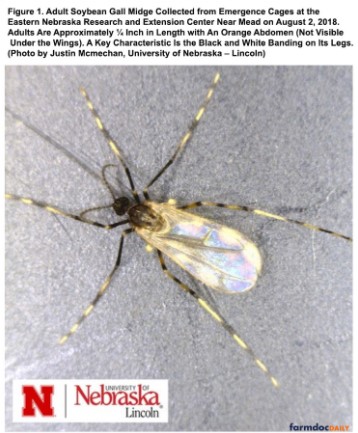
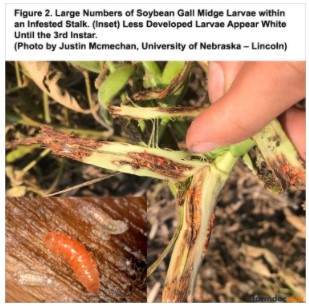
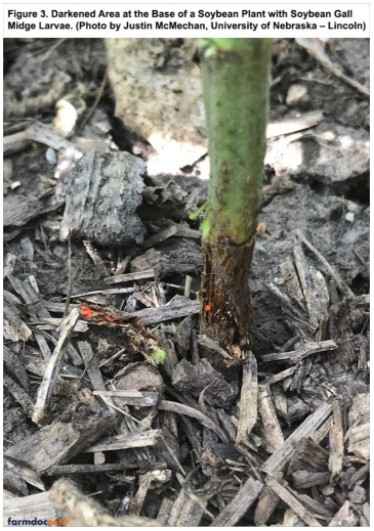
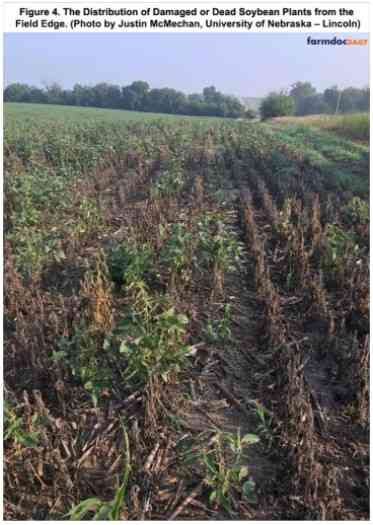
The SGM overwinters as a larva in the soil of the soybean field, they pupate and emerge as adults in June and July. Subsequent infestations are most likely on the edges of soybean fields that are adjacent to soybean fields that were infested during the previous year. Adults are believed to lay eggs at the base of soybean plants. Early indications of an infestation may include discoloration of plant stems near the soil interface, more advanced infestations may manifest as wilting or dead plants. Peeling back the epidermis of an infested stem will reveal the presence of bright orange larvae. There are multiple generations each year. University of Nebraska data suggest that there is no single approach that will manage SGM. University of Nebraska has published some considerations that may help growers manage fields at high risk from SGM (
https://cropwatch.unl.edu/2020/2020-soybean-gall-midge-alert-network).
Illinois had a surveying role in a large regional SGM sampling project supported by Checkoff funding through the North Central Soybean Research Program (NCSRP). The project, “Soybean Gall Midge: Surveying the North Central Region, Adult Monitoring and Host Plant Resistance”, was focused primarily on regions to our west where SGM was first discovered in 2018 and the expanding area of infested counties. During 2020, infestations in 19 additional counties were documented, bringing the total number of infested counties to 114 across South Dakota, Nebraska, Minnesota, Iowa, and Missouri. The nearest infestation to an Illinois border is >140 miles away in Central Iowa. The current distribution of infested counties is available at:
https://soybeangallmidge.org/
Despite travel challenges associated with COVID-19 restrictions, during the summer of 2020, we sampled 208 soybean fields in 45 Illinois counties. No evidence of SGM activity was detected anywhere in Illinois during our July-August survey. The Illinois map of sampled locations is presented below (Figure 5).
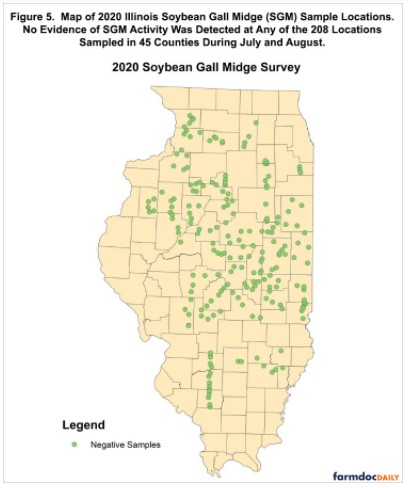
Though the 2020 monitoring effort was funded for only one year, we will continue monitoring for SGM in 2021 and beyond.
We encourage Illinois producers to photograph and report any suspected SGM damage observed in Illinois soybean fields during 2021.
Source : illinois.edu